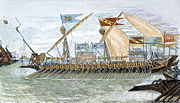Battle of Curzola
| Battle of Curzola | |||||||
|---|---|---|---|---|---|---|---|
| Part of the Venetian–Genoese Wars | |||||||
 The Triumph of Lamba Doria | |||||||
| |||||||
| Belligerents | |||||||
|
[1][2][3][4] |
[1][2][3][4] | ||||||
| Commanders and leaders | |||||||
|
[5][6][2][7] |
[6][2][4][8] | ||||||
| Strength | |||||||
| 66–75 galleys[2][4][9] | 95 galleys[6][3][9][10] | ||||||
| Casualties and losses | |||||||
| Heavy[8] |
7,000–9,000 killed [7][10][11] 5,000–7,000 captured [4][7][8][9] 65–83 galleys lost [2][3][9][11] | ||||||
Battle of Curzola (today Korčula,[10] southern Dalmatia, now in Croatia) was a naval battle which was fought on September 9, 1298 between the fleets of Genoa and Venice; it was a disaster for Venice, a major setback among many battles fought in the 13th and 14th centuries between Pisa, Genoa and Venice in a long series of wars for the control of Mediterranean and Levantine trade.
Battle
The battle took place in the channel between the island of Curzola (Korčula) and the mainland peninsula of Sabbioncello (Pelješac), and ashore, where Venetian men had been landed on the island's far side.[citation needed] The Venetians were led by Admiral Andrea Dandolo, son of Doge Giovanni Dandolo, and the Genoese by Lamba Doria, whose son was killed in the fighting: "Throw my son overboard into the deep sea," Doria was said to have ordered: "What better resting place can we give him?".[citation needed]

The fleets of the two states were apparently equal in number, but, after the Venetians ran their galleys aground while trying to capture the Genoese galleys, Doria exhibited superior strategy and managed to inflict a resounding defeat on his enemies. The disaster seemed almost complete for Venice: 83 of their 95 ships were destroyed and about 7,000 men were killed.[10] The Genoese were victorious and Dandolo committed suicide in his first days of captivity. Venice suffered heavy losses, but she managed to immediately equip another 100 galleys and sought to obtain reasonable peace conditions that did not significantly hamper its power and prosperity.[citation needed]
According to a later tradition (16th Century) recorded by Giovanni Battista Ramusio, Marco Polo was one of those among the Venetian prisoners and he dictated his famous book during the few months of his imprisonment; but whether he was actually caught at this battle or at a previous minor engagement near Laiazzo (Ayas) is unclear.[12]
Sources
- ^ a b c d Bradbury, Jim (2004). The Routledge Companion to Medieval Warfare. London.
{{cite book}}: CS1 maint: location missing publisher (link) - ^ a b c d e f Wislicenus, Georg (2007). Deutschlands Seemacht. Leipzig.
{{cite book}}: CS1 maint: location missing publisher (link) - ^ a b c d Ersch, Johann Samuel (1846). Allgemeine Encyclopädie der Wissenschaften und Künste: 25.Theil. Leipzig.
- ^ a b c d e Damberger, Joseph F. (1851). Synchronistische Geschichte der Kirche und der Welt im Mittelalter: Vol.12. Regensburg.
{{cite book}}: CS1 maint: location missing publisher (link) - ^ a b Kleinhenz, Christopher (2004). Medieval Italy: an encyclopedia: Vol.1. New York.
{{cite book}}: CS1 maint: location missing publisher (link) - ^ a b c d Leo, Heinrich (1829). Geschichte der italienischen Staaten: -4. th. Vom Jahre 1268 bis 1492. Hamburg.
- ^ a b c Bianchi Giovini, Aurelio (1871). Storia dei papi da san Pietro a Pio IX. Milan.
{{cite book}}: CS1 maint: location missing publisher (link) - ^ a b c Hazlitt, William Carew (1860). History of the Venetian republic: Vol.2. London.
{{cite book}}: CS1 maint: location missing publisher (link) - ^ a b c d Smedley, Edward (1832). Sketches from Venetian history: Vol.1. New York.
- ^ a b c d Nicol, Donal M. (1992). Byzantium and Venice: A Study in Diplomatic and Cultural Relations. Cambridge University Press.
{{cite book}}: CS1 maint: location missing publisher (link) - ^ a b Società ligure di storia patria (1984). Genova, Pisa e il Mediterraneo tra Due e Trecento. Genoa.
{{cite book}}: CS1 maint: location missing publisher (link) - ^ Polo, Marco; Latham, Ronald (translator) (1958). The Travels of Marco Polo, p. 16. New York: Penguin Books. ISBN 0-14-044057-7.
External links
